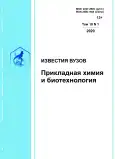Aspects of lithium tri- and tetraborate synthesis in the subsolidus region
- Авторлар: Mamontova S.G.1, Dergin A.A.1, Nepomnyashchikh A.I.1, Kaneva E.V.1
-
Мекемелер:
- A.P. Vinogradov Institute of Geochemistry SB RAS
- Шығарылым: Том 10, № 1 (2020)
- Беттер: 6-13
- Бөлім: Chemical Sciences
- URL: https://bakhtiniada.ru/2227-2925/article/view/299259
- DOI: https://doi.org/10.21285/2227-2925-2020-10-1-6-13
- ID: 299259
Дәйексөз келтіру
Толық мәтін
Аннотация
Авторлар туралы
S. Mamontova
A.P. Vinogradov Institute of Geochemistry SB RAS
Email: svelta@igc.irk.ru
A. Dergin
A.P. Vinogradov Institute of Geochemistry SB RAS
Email: dergin@igc.irk.ru
A. Nepomnyashchikh
A.P. Vinogradov Institute of Geochemistry SB RAS
Email: ainep@igc.irk.ru
E. Kaneva
A.P. Vinogradov Institute of Geochemistry SB RAS
Email: kaneva@igc.irk.ru
Әдебиет тізімі
- Anjaiah J., Laxmikanth C., Veeraiah N., Kristaiah P. Luminescence properties of Pr3+ doped Li2O– MO–B2O3 glasses // Journal of Luminescence. 2015. Vol. 161. P. 147–153. https://doi.org/10.1016/j.jlumin.2015.01.007
- Pawar P.P., Munishwar S.R., Gedam R.S. Intense white light luminescent Dy3+ doped lithium borate glasses for W-LED: A correlation between physical, thermal, structural and optical properties // Solid State Sciences. 2017. Vol. 64. P. 41–50. https://doi.org/10.1016/j.solidstatesciences.2016.12.009
- Laorodphan N., Kidkhunthod P., Khajonrit J., Montreeuppathum A., Chanlek N., Pinitsoontorn S., et al. Effect of B2O3 content on structure-function of vanadium‑lithium-borate glasses probed by synchrotron-based XAS and vibrating sample magnetrometry technique // Journal of Non-Crystalline Solids. 2018. Vol. 497. P. 56–62. https://doi.org/10.1016/j.jnoncrysol.2018.04.045
- Saidu A., Wagiran H., Saeed M.A., Obayes H.K., Bala A., Usman F. Thermoluminescence response of rare earth activated zinc lithium borate glass // Radiation Physics and Chemistry. 2018. Vol. 144. P. 413–418. https://doi.org/10.1016/j.radphyschem.2017.10.004
- Neumair S.C., Vanicek S., Wurst K., Huppertz H., Kaindl R., Többens D.M. High-pressure synthesis and crystal structure of the lithium borate HP-LiB3O5 // Journal of Solid State Chemistry. 2011. Vol. 184. Issue 9. P. 2490–2497. https://doi.org/10.1016/j.jssc.2011.07.011
- Sanyal B., Goswami M., Shobha S., Prakasan V., Chawla S.P., Krishnan M., et al. Synthesis and characterization of Dy3+ doped lithium borate glass for thermoluminescence dosimetry // Journal of Non-Crystalline Solids. 2017. Vol. 475. P. 184– 189. https://doi.org/10.1016/j.jnoncrysol.2017.09.016
- Ramteke D.D., Ganvira V.Y., Munishwar S.R., Gedam R.S. Concentration Effect of Sm3+ Ions on Structural and Luminescence Properties of Lithium Borate Glasses // Physics Procedia. 2015. Vol. 76. P. 25–30. https://doi.org/10.1016/j.phpro.2015.10.005
- Kindrat I.I., Padlyak B.V., Drzewiecki A. Luminescence properties of the Sm-doped borate glasses // Journal of Luminescence. 2015. Vol. 166. P. 264–275. https://doi.org/10.1016/j.jlumin.2015.05.051
- Mhareb M.H.A., Hashim S., Ghoshal S.K., Alajerami Y.S.M., Bqoor M.J., Hamdan A.I., et al. Effect of Dy2O3 impurities on the physical, optical and thermoluminescence properties of lithium borate glass // Journal of Luminescence. 2016. Vol. 177. P. 366–372. https://doi.org/10.1016/j.jlumin.2016.05.002
- Danilyuk P.S., Volovich P.N., Rizak V.M., Puga P.P., Gomonai A.I., Krasilinets V.N. X-ray luminescence and spectroscopic characteristics of Er3+ ions in a glassy lithium tetraborate matrix // Optics and Spectroscopy. 2015. Vol. 118. Issue 6. P. 924–929. https://doi.org/10.1134/S0030400X15060089
- Rimbach A.C., Steudel F., Ahrens B., Schweizer S. Tb3+, Eu3+, and Dy3+ doped lithium borate and lithium aluminoborate glass: Glass properties and photoluminescence quantum efficiency // Journal of Non-Crystalline Solids. 2018. Vol. 499. P. 380–386. https://doi.org/10.1016/j.jnoncrysol.2018.07.029
- Bødker M.S., Mauro J.C., Youngman R.E., Smedskjaer M.M. Statistical mechanical modeling of borate glass structure and topology: prediction of superstructural units and glass transition temperature // Journal of physical chemistry b: biophysical chemistry, biomaterials, liquids, and soft matter. 2019. Vol. 123. Issue 5. P. 1206–1213. https://doi.org/10.1021/acs.jpcb.8b11926
- Rollet A.P., Bouaziz R. The binary system: lithium oxide-boric anhydride // Comptes Rendus de l'Académie des Sciences. 1955. Vol. 240. Issue 25. P. 2417–2419.
- Sastry B.S.R., Hummel F.A. Studies in Lithium Oxide Systems: I, Li2O-B2O3 // Journal of the American Ceramic Society. 1958. Vol. 41. Issue 1. P. 7–17. https://doi.org/10.1111/j.11512916.1958.tb13496.x
- Мешалкин А.Б. Исследование фазовых равновесий и оценка термодинамических свойств расплавов в бинарных боратных системах // Теплофизика и аэромеханика. 2005. Т 12. N 4. С. 669–684.
- Воронько Ю.К., Соболь А.А., Шукшин В.Е. Исследование фазовых превращений в LiB3O5 и Li2B4O7 при нагревании и плавлении методом спектроскопии комбинационного рассеяния света // Неорганические материалы. 2013. Т. 49. N 9. С. 991–997. https://doi.org/10.7868/S0002337X13090200
- Bazarova Zh.G., Nepomnyashchikh A.I., Kozlov A.A., Bogdan-Kurilo V.D., Bazarov B.G., Subanakov A.K., et al. Phase Equilibria in the Sys-tem Li2O–MgO–B2O3 // Russian Journal of Inorganic Chemistry. 2007. Vol. 52. Issue 12. P. 1971–1973. https://doi.org/10.1134/S003602360712025X
- Depci T., Özbayoğlu G., Yilmaz A. The effect of different starting materials on the synthesis of lithium triborate // Physicochemical Problems of Mineral Processing. 2007. Vol. 41. P. 101–105.
- Mikhailov M.A., Mamontova S.G., Zelentcov S.Z., Demina T.V., Belozerova O.Yu., Bogdanova L.A. On the Coexistence of Chemically Similar Stable and Metastable Phases in the BeO–MgO–Al2O3– SiO2 System // Journal of Surface Investigation: X-ray, Synchrotron and Neutron Techniques. 2018. Vol. 12. Issue 4. P. 756–760. https://doi.org/10.1134/S1027451018040328
- Gorelik V.S., Vdovin A.V., Moiseenko V.N. Raman and hyperrayleigh scattering in lithium tetraborate crystals // Journal of Russian Laser Research. 2003. Vol. 24. Number 6. P. 553–605. https://doi.org/10.1023/B:JORR.0000004168.99752.0e
Қосымша файлдар









